
1472 - 1553

Self Portrait: 1550
Mythological and Allegorical Nudes
The Judgment of Paris: 1512-14
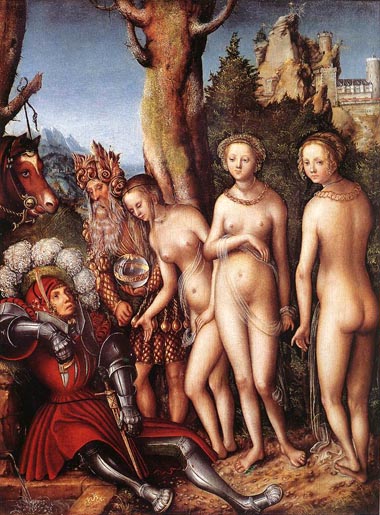
This mythological theme was very popular with the humanist-educated bourgeoisie as well as the court and Cranach the Elder painted it often.
The Judgment of Paris
The Judgment of Paris was a contest between the three most beautiful goddesses of Olympus--Aphrodite, Hera and Athena--for the prize of a golden apple addressed to "the fairest"
The story begins at the Wedding of Peleus and Thetis to which all of the gods were invited, all except Eris, the goddess of discord. When she appeared at the festivities, she was turned away, and in her anger cast a golden apple amongst the assembled goddesses addressed "To the Fairest." Three goddesses laid claim to the apple--Aphrodite, Hera and Athena. Zeus was asked to mediate and he commanded Hermes to lead the three goddesses to Paris of Troy to decide the issue. The three goddesses appearing before the shepherd prince, each offering him gifts for favor. He chose Aphrodite, swayed by her promise to bestow upon him Helen, the most beautiful woman, for wife. The subsequent abduction of Helene led directly to the Trojan War and the fall of the city.
The Judgment of Paris: 1528
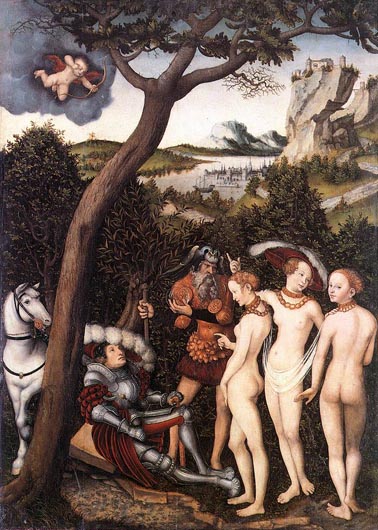
Cranach was one of the most versatile artists of the Northern Renaissance, a staunch patron of the Reformation, and a close friend of Martin Luther. He painted didactic religious paintings, but he also produced his own erotic ideal of the female nude. Although his style, unlike that of Dürer, borrowed little from the Italians, he favored mythological and classical subjects and painted the story of the 'Judgment of Paris' many times during the course of his career. Here the artist has chosen a German version of the story, in which Mercury presents the three goddesses - Juno, Venus, and Minerva - to Paris in a dream. Cranach signals Venus's victory by placing Cupid, her son, in the upper left, aiming in her direction as she points to him. The figures of the three women give the artist an opportunity to make a visual tour of the female nude from different perspectives.
Apollo and Diana

Cranach, like his contemporary Albrecht Dürer, was a dominant figure in German Renaissance painting. The influence of both artists was pervasive, although Cranach had the advantage of outliving Dürer by as much as thirty years. At the start of his career he was active in Munich and Vienna, but in 1505 he became court painter to Duke Friedrich the Wise of Saxony. Cranach held this position under two successive Electors until 1547, and again from 1550 until his death. The court was based at Wittenberg until the Elector Johann Friedrich went into exile in Augsburg (1547-52). After his return the Elector preferred to live in Weimar. Cranach carried out a wide range of duties as court artist including the decoration of the palace, but he was granted a coat-of-arms in 1508 and became wealthy, holding public office several times. The mark or signature of a flying snake that occurs on this panel and many others was derived from his coat-of-arms. Cranach was also a prolific engraver and book illustrator with an interest in publishing, particularly in Reformation literature. He was a close friend of Martin Luther and his family, whose portraits he painted frequently, although, like many other artists in Germany during these years, he retained Catholic patrons such as Cardinal Albrecht of Brandenburg, Elector of Mainz.
The subject of Apollo and Diana was treated on two other occasions by Cranach (Brussels, Musée des Beaux-Arts and Berlin, Gemäldegalerie). There are considerable differences between the three compositions, although in each case Apollo stands and Diana is seated on a stag. The painting in Brussels and the present work show Apollo about to shoot an arrow, whereas in the painting in Berlin (1530) he is without a quiver and merely holds three arrows in the same hand as the bow. The composition with Apollo aiming is comparable with the engraving by Dürer of about 1505, or with the print by Jacopo de' Barbari. The figure of Diana holding her right foot with one leg crossed over the other is reminiscent (although reversed) of the famous antique bronze known as the Spinario.
The painting in the Royal Collection reveals all the main characteristics of Cranach's art. The tautness of the style, the fluency of the drawing of the nude, the love of greens and blues offsetting the lighter flesh tones, the detailed rendering of foliage and the carefully observed landscape replete with a perilously balanced castle on a distant crag and peaceful reflections in calm waters, these are the hallmarks of his finest works, and, it has to be admitted, also of his studio. The intensity of the style is matched by the studied care of the composition and by the clarity of the image.
The painting is signed with the image of a winged serpent.
The Three Graces: 1535
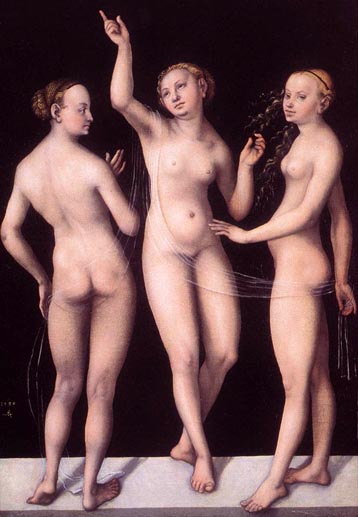
In Greek mythology, the Three Goddesses of Joy, Charm, and Beauty. The daughters of the god Zeus and the nymph Eurynome, they were named Aglaia (Splendor), Euphrosyne (Mirth), and Thalia (Good Cheer). The Graces presided over banquets, dances, and all other pleasurable social events, and brought joy and goodwill to both gods and mortals. They were the special attendants of the divinities of love, Aphrodite and Eros, and together with companions, the Muses, they sang to the gods on Mount Olympus, and danced to beautiful music that the god Apollo made upon his lyre. In some legends Aglaia was wed to Hephaestus, the craftsman among the gods. Their marriage explains the traditional association of the Graces with the arts; like the Muses, they were believed to endow artists and poets with the ability to create beautiful works of art. The Graces were rarely treated as individuals, but always together as a kind of triple embodiment of grace and beauty. In art they are usually represented as lithe young maidens, dancing in a circle.
Lucretia: 1533

Cranach painted many slant-eyed, narrow-waisted, high-breasted nudes with highly charged eroticism. These nudes - depicted to order or almost mass-produced - came in life-size as this Venus and Cupid, or practically pocket-size.
Lucretia: 1524
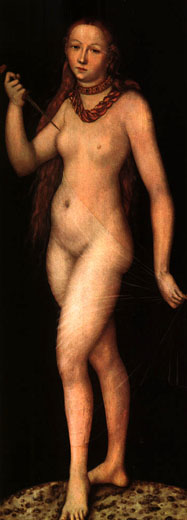
Tne Legend of Lucretia
Lucretia is a legendary figure in the history of the Roman Republic. According to the story, told mainly by two Roman Historians, Livy and Dionysius of Halicarnassus, her rape by the king's son and consequent suicide were the immediate cause of the Revolution that overthrew the monarchy and established the Roman Republic. The incident kindled the flames of dissatisfaction over the tyrannical methods of the last king of Rome, Lucius Tarquinius Superbus. As a result, the prominent families instituted a Republic, drove the extensive Tarquin family from Rome, and successfully defended the republic against attempted Etruscan and Latin intervention. The rape has been a major theme in European art and literature.
Charity
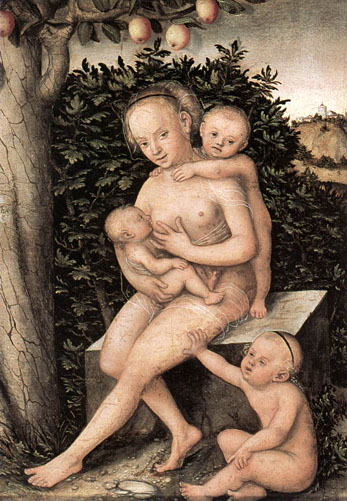
The nude Caritas, or Charity, is surrounded by three children. In this way, the protestant Cranach imbued his subject with a quality of motherly love, despite the fact that he is more concerned with the female body than the emblematic aspect of the subject. Cranach's nudes are immediately recognizable and he glorified them in numerous mythological and biblical scenes.
Reclining River Nymph at the Fountain: 1518

The resurgence of Gothic linear rhythms is fundamental for the whole of Cranach's later work, in which the borderline between sacred and mundane art is blurred. He represented female saints as beautiful and elegant ladies in fashionable dress and covered with jewelry. His Reclining River Nymph at the Fountain (1518 Leipzig) shows with what assurance he translated a Renaissance model - Giorgione's Venus - into his personal language of linear arabesque. This work inaugurated a long series of paintings of Venus, Lucretia, the Graces, the judgment of Paris, and other subjects that serve as pretexts for the sensuous female nude, in which Cranach appears as a kind of 16th-century François Boucher.
There exists several copys of this painting made by the workshop of Cranach. The original painting is in Leipzig.
Reclining Nymph: 1530-34
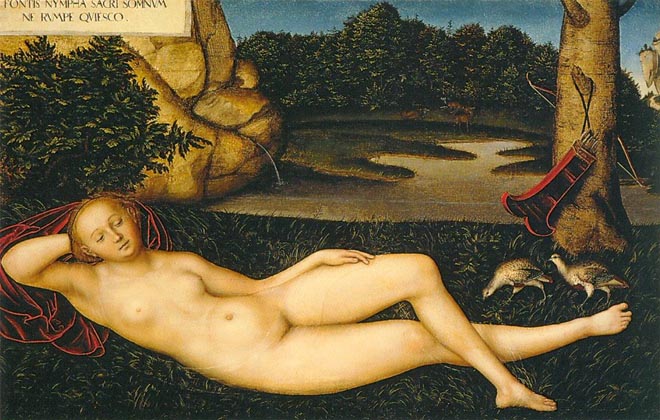
Translation of the inscription upper left:
"I am the nymph of the sacred fountain. Do not interrupt my sleep as I am resting."
In addition to religious subjects and portraits, Cranach also painted mythological scenes which drew on the new Protestant thinking, resulting in some very unusual interpretations of classical mythology, as can be seen in the Reclining Nymph. Cranach has developed a canon of female beauty which is totally at odds with the classical ideal and is charged with a powerful eroticism.
The Nymph of the Fountain: 1534
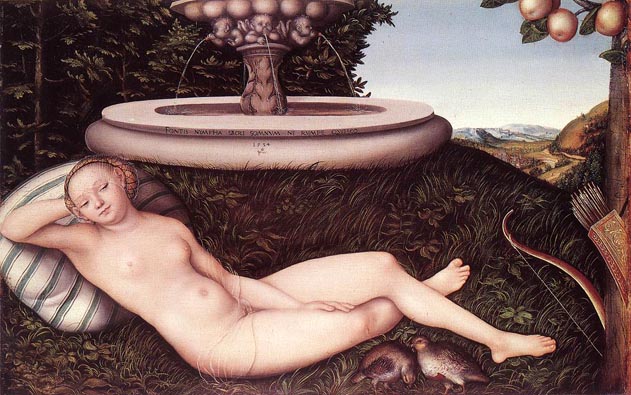
Venus and Cupid: 1509
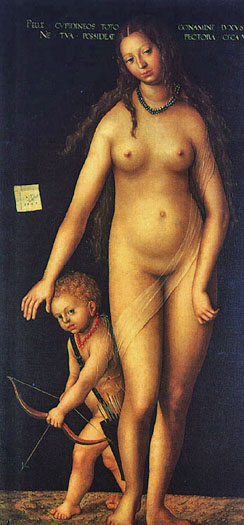
This is the earliest of Cranach's mythological paintings and the first in Germany depicting Venus and Cupid. At the top a poem in Latin explains the meaning of the picture. The composition is strongly influenced by Dürer.
Venus Standing in a Landscape: 1529

The origin of this picture is unknown. It is one of a series of paintings in various sizes, representing Venus or a female nude, turned out in quantities by Cranach and his studio; these were popular among the clientele of humanists for whom he worked. However, this conception of Venus belongs to a German tradition which derives its inspiration from Gothic art. The juvenile air, the slender forms, the tiny breasts an narrow hips, the rounded forehead, all go to make up the physical characteristics of the women (including the Virgins) represented in German art since the fourteenth century. This is quite unlike the conception of Dürer's Eve (1504), which was based on an objective and scientific study of the proportions of the human body.
The Venus is clad only in a provocatively transparent veil; in some paintings this is a subsequent addition, but here it is original. The better to set off the ivory whiteness of her body, Cranach has shown it silhouetted against a somber background of foliage. The landscape conveys in a few strokes an intense impression of the Germanic conception of nature.
Cupid Complaining to Venus: 1530
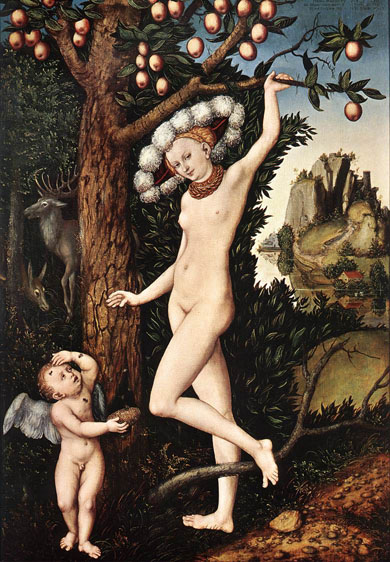
The Reclining River Nymph at the Fountain (1518, Leipzig) inaugurated a long series of paintings of Venus, Lucretia, the Graces, the judgment of Paris, and other subjects that serve as pretexts for the sensuous female nude, in which Cranach appears as a kind of 16th-century Francois Boucher. The naive elegance of these ladies, whose slender, sinuous bodies defy basic principles of anatomy, were clearly to the taste of the German courts and have an enduring charm. But in conception and style they look back to the International Gothic style of a century before. Thus from a historical viewpoint Cranach's work was a backwater in European art of the 16th century. And though he was the dominant figure in the painting of northeastern Germany during his lifetime, his influence was confined to his immediate circle.
Venus and Cupid: 1531
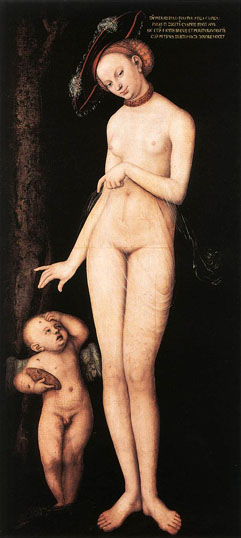
Renaissance scholars attributed to Theocrites, the 3rd century BC Greek poet, the fable that recounts how Cupid, having been stung by bees when stealing honey, complained to his mother Venus about the pain produced by such small animals. To which she replied that he too was small and that the wounds occasioned by his arrows were much more painful. Cranach knew this text from the translation by his friend Melanchton, whom he had met in the intellectual circles that he frequented at Wittenberg. The Latin verses at the top of the painting explain the subject. This gave the artist the opportunity to paint nudes, their strong sensuality conflicting with the moralizing side of the story. Treated several times by Cranach himself or by his workshop, this mythological subject matched the taste of the Prince-Electors of Saxony, who commissioned these works to decorate their private apartments. The version in Brussels is one of the most successful out of twenty or so known variants.
Venus' white, weakly modeled body stands out against a black background in a sinuously seductive pose. The artist's interest in the human body is very superficial, far from the anatomical researches undertaken so passionately by his contemporaries. The few accessories adorning the model, like the heavy red velvet hat or the precious necklace enriched with stones, are clearly added for erotic intent. The light, transparent veil attracts the viewer's attention much more than hiding any nudity. The goddess's oblique glance and almond-shaped eyes increase the equivocal nature of this image. Through the harmony of this drawing, Cranach nonetheless succeeds in transcending this seductive aspect and responds to Theocritus' verses by creating a veritable visual poem in which the fluid lines of the model, of rarely equaled elegance, snake melodiously through space. Alongside Venus, the baby winged Cupid holds the honeycomb that he has just stolen, a source of immediate pleasure but also of pain. Behind him, the uniformity of the dark background is broken by a tree, at the base of which we find the mark of the artist's workshop, taken from the coat-of arms granted to him by the Elector of Saxony: a winged serpent with outspread wings, and the date 1531.
Venus and Cupid with a Honeycomb: 1531
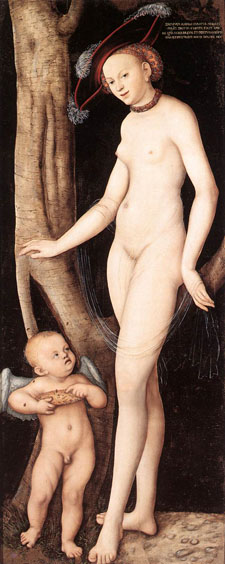
Around 1525, Cranach (a leading painter of the German Renaissance, who had trained in Flemish studios) painted a Venus draped in a transparent veil gazing directly at the spectator, whose refined flowing lines are far-removed from the style of ancient statues. The fine brushwork captures every wrinkle in the bark of the tree and every feather in the wings. Cranach decided to accompany his nude figure with a moralizing couplet by the Humanist Chelidonius which reminds us that 'voluptas' is transitory and accompanied by pain, as the little Cupid realizes when he tastes the honeycomb with its stinging bees.
The date 1531 inscribed on the painting is not thought to be original and it is believed that it has actually been executed around 1525.
Venus and Cupid: 1525

Cranach's depictions of the female nude, with their sophisticated sensuality and smooth, sinuous contours, have long been among the most coveted and successful of his creations. This example, which dates to 1525, is the earliest of Cranach's intimate small scale panels of the subject of Venus and Cupid.
Venus and Cupid: ca 1530

Cranach painted many slant-eyed, narrow-waisted, high-breasted nudes with highly charged eroticism. These nudes - depicted to order or almost mass-produced - came in life-size as this Venus and Cupid, or practically pocket-size.
Biblical Nudes (Adam and Eve)
Adam and Eve: 1528
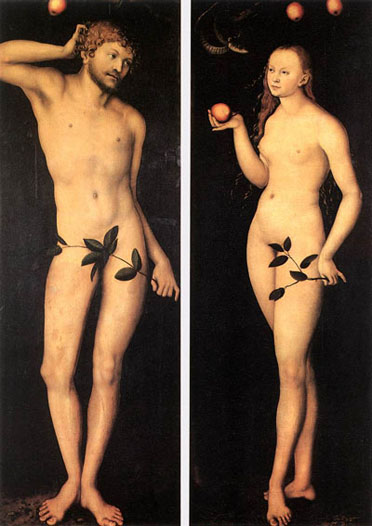
To the rigorous, perfectly Renaissance Dürer, troubled by the question of the proportions of the human body, Cranach, in his nudes, responds by freeing himself from every rule and from any observation of anatomical accuracy. His figures are elongated out of all proportion, seem boneless and are shown in affected, theatrical poses. The naked bodies, ivory-colored against a dark background, emanate a totally cold, intellectual eroticism. The effect is accentuated in this work, for example, by the malicious gesture with which Eve holds out the apple, with her other hand bent unnaturally to hold the frond which covers her loins, but above all by the sly expression on her slightly cruel face.
Adam and Eve: 1531
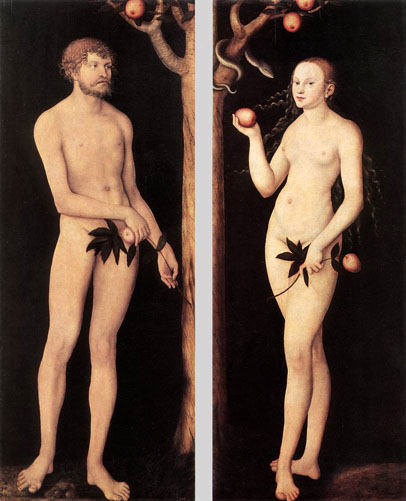
The paintings are signed and dated.
Adam and Eve: 1533
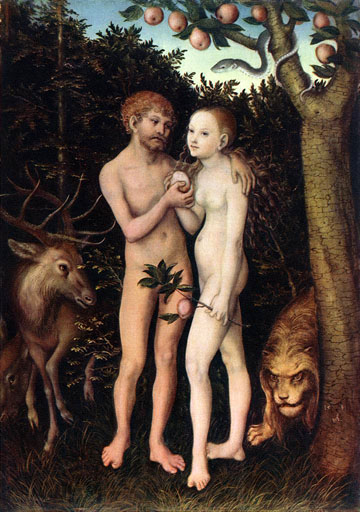
Adam and Eve: 1538
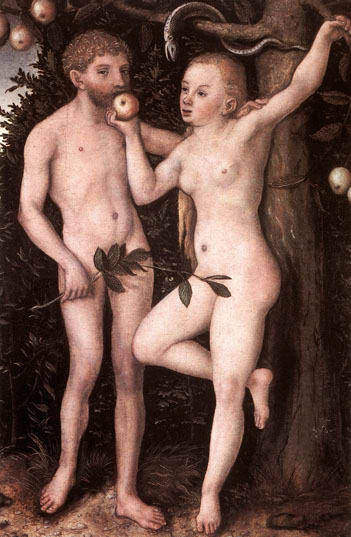
Adam and Eve - Woodcut: 1509
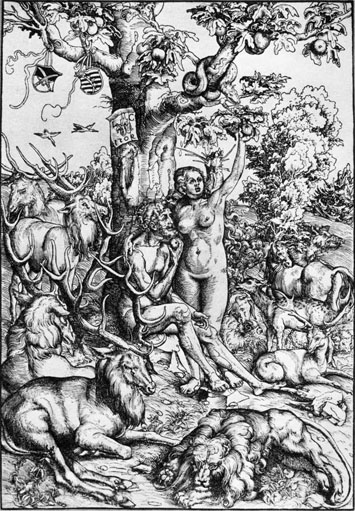
Lucas Cranach, who was to become court painter to the Elector of Saxony, performed other tasks for a livelihood before this honor was bestowed upon him. He was for a time a pharmacist, a burgomaster of Wittenberg, and the director of a factory for the production of pictures. He may have turned to designing woodcuts for the monetary rewards involved, for they were much in demand in Germany at the beginning of the sixteenth century. Even the greatest painters of the period contributed to the illustration of books, and made single-sheet prints and series of pictures of a religious character - often with imperial sponsorship. Dürer, Holbein, and Lucas van Leyden were among the more famous painters who engaged in the production of prints.
Cranach was more competent as a painter than as a printmaker. Apparently he did not find the medium a congenial one; perhaps he used it to satisfy financial needs, or because it was considered a worthy and lucrative profession by the best artists of his country.
This scene of Adam and Eve in the Garden is typical of his style - of its virtues and defects. He had a tendency to overcrowd his compositions, to overstress secondary details, and to fail to concentrate on the main theme. The central figures stand before a huge tree (Cranach did not omit the arms of the Elector of Saxony, hanging on one of the limbs). Adam, a somewhat emaciated type, is seated next to a standing Eve, similar in proportion and sexuality to Venus and other comely goddesses who often appear in Cranach's paintings.
Cranach gave equal attention to the various animals surrounding the figures. They are drawn with incredible dexterity based on a sound knowledge of their respective anatomies. Though hardly equal to Dürer's accomplishment in the art of the woodcut, this print by Cranach has an intriguing quality of its own.
The Paradise: 1530
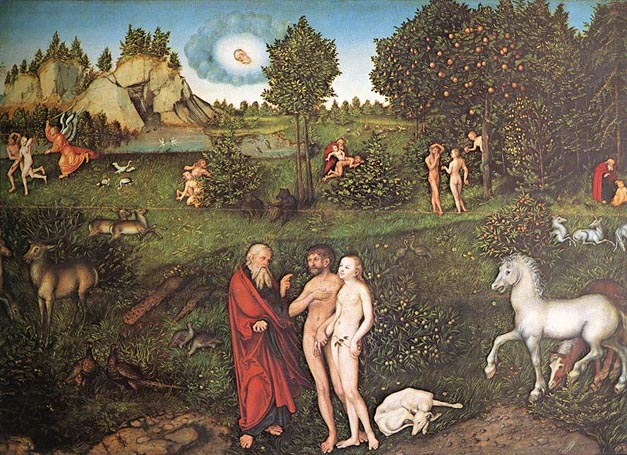
Paintings of Religious Subject-Matter (until 1515)
The Crucifixion: 1500-03
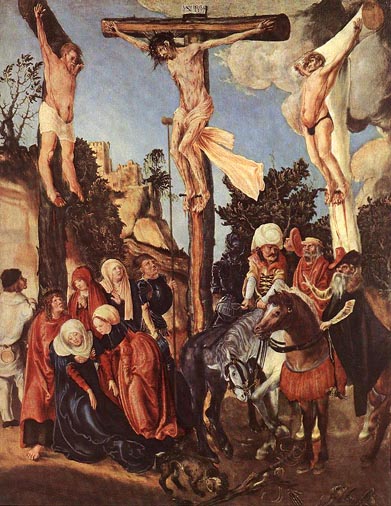
This is the earliest known painting of Cranach, executed for the Schottenkirche in Vienna.
Cranach's style was fully formed and underwent little development after about 1515, and the highly finished, mass-produced paintings after that date suffer by comparison with the more individual works he painted in early adulthood. The paintings the 30-year-old artist did in Vienna were of a profoundly devotional kind set in the wild landscapes of the Alpine foothills, with ruins and windswept trees. These pictures show Cranach as an avant-garde artist of considerable emotional force, and one of the initiators of the Danube school. Notable among them is the Crucifixion in the Kunsthistorisches Museum, Vienna.
Crucifixion: 1503

The Martyrdom of Saint Catherine: 1504-05
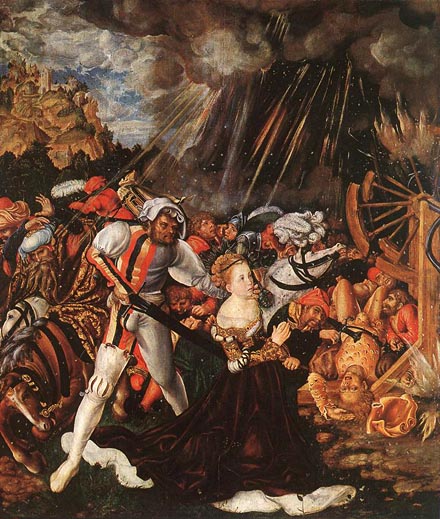
The painting was executed after Dürer's engraving of the same subject (in a mirrored composition) and it is closer to the style of Dürer than any other work by Cranach.
The Martyrdom of Saint Catherine: 1506
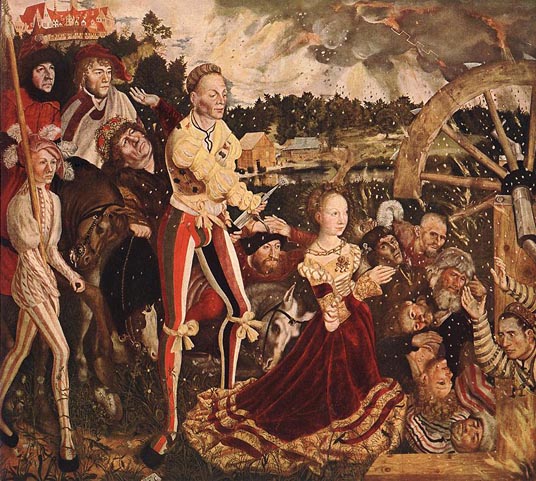
The central panel of a triptych, the side wings representing three female saints each. The painting depicts to moments of the martyrdom, one when the lightning destroys the wheel and the other the beheading. The two equestrian men at the left are Frederic the Wise and John the Steadfast.
House Altar of Count William II of Hessen: 1508
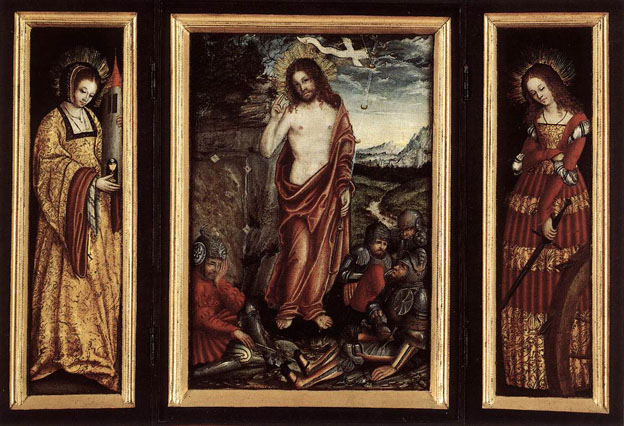
This altarpiece was produced for the Kassel court, but it cannot be said with certainty whether it was indeed commissioned by Landgrave Wilhelm II of Hesse, an ally of the Emperor Maximilian and for a time one of the most powerful princes of the Holy Roman Empire.
On the central panel we see the risen Christ, with the flag of victory on a glass staff in his left hand. His right hand is raised in a gesture of victory. On the side panels are two auxiliary saints, or Holy Helpers: Saint Barbara, patroness of the dying, and Saint Catherine, patroness of the sick.
Altar Piece of The Holy Family: 1509
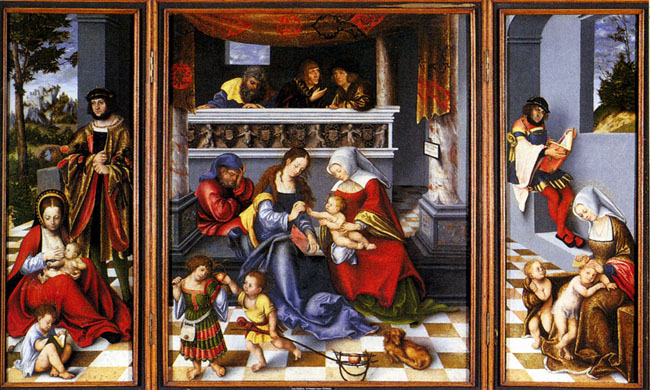
Trinity: 1515-18
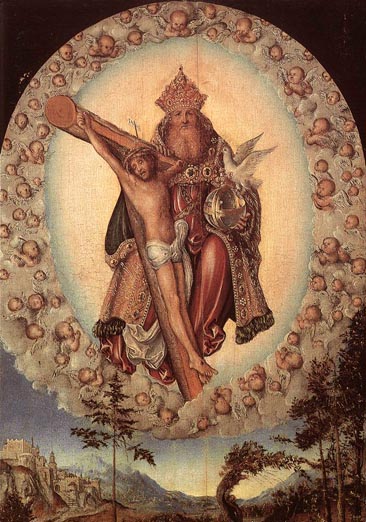
The Trinity
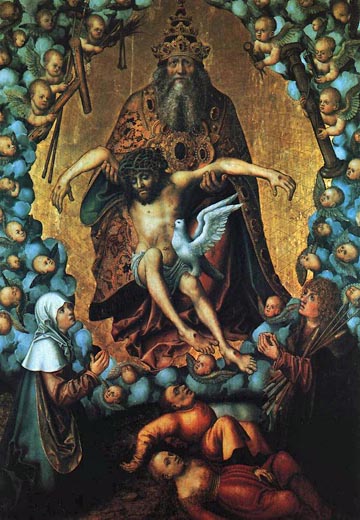
Head of Christ Crowned with Thorns: ca 1510
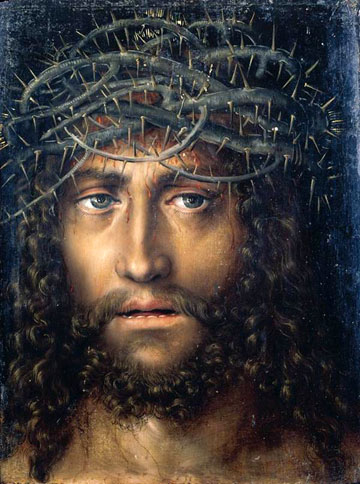
The type of image derives from Early Netherlands' painting (Jan van Eyck and Dirk Bouts the Elder).
Virgin and Child with a Bunch of Grapes: 1509-10
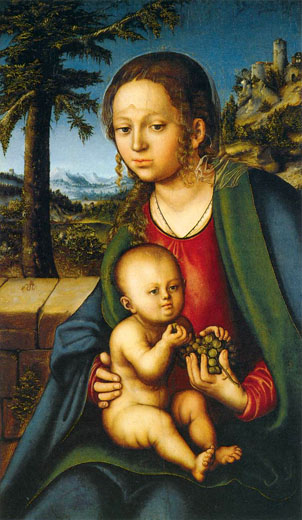
The Virgin is holding a bunch of grapes which the Infant Christ is eating. Behind the figures lies an extensive mountainous landscape and above it a brilliant blue sky. The mountains in the background take on a blue hue, a device used to represent the effects of atmosphere on a distant landscape. The cold and monochromatic tones of the landscape serve to emphasize the strong colors of the main figures.
Saints Elizabeth and Anne (inside): ca 1514
_ca_1514.jpg)
These two panels, painted on both sides, depict a total of four saints. The panels are probably the wings of a triptych whose central panel is now lost. It was commissioned by the Duke of Saxony, who is portrayed with his wife in the lower half of the panels. One of the inside panels depicts Saint Elizabeth, Mary's cousin and the mother of Saint John the Baptist. Below her and shown praying in much less than life-size proportions, is the Duke. The other panel depicts Saint Anne, the Virgin's mother, with the Duchess. The saints are identified by their names written in their haloes. The outer side of the wings (not shown here) depicts Saint Christopher with the Christ Child on his shoulders, and Saint George and the Dragon.
Saints Christopher and George (outer side): ca 1514
_ca_1514.jpg)
Maximilian I by Albrecht Durer

Portrait of Charles V: 1533 by Lucas Cranach the Elder
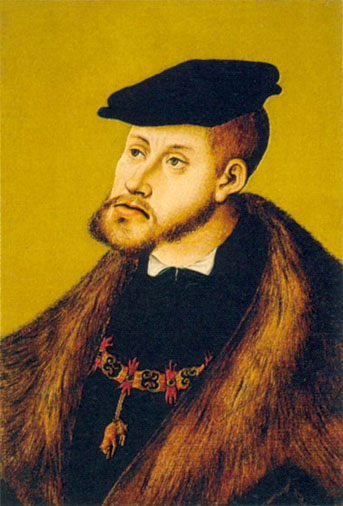
Katharina von Bora: ca 1525

Elector John Frederick
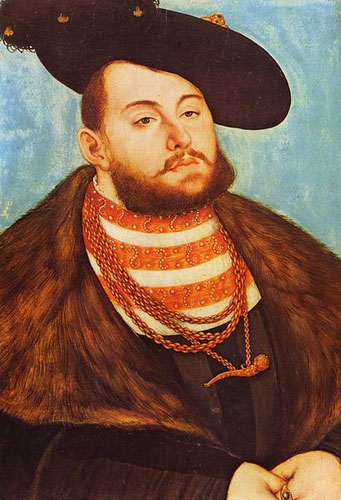
The Rest on the Flight into Egypt: 1504
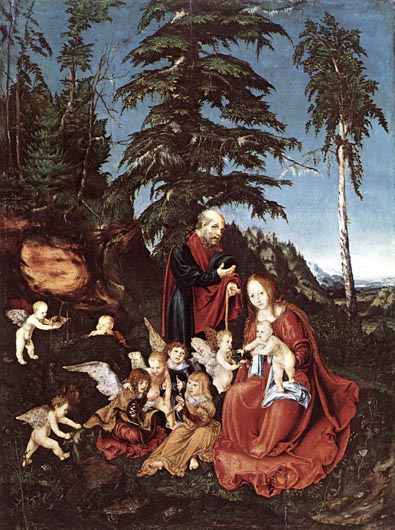
The Virgin has settled down to rest in a meadow on the edge of a forest. Supported by her, the child Jesus reaches out for the strawberries which an angel is offering him. Another angel is drawing water from a spring, a third is bringing a bird, while others sit in the grass and make music. Joseph, holding his hat and staff, stands, as if on guard, behind the group.
The representation of the Holy Family, who have interrupted their journey in a fresh summer landscape, has always been treated as a romantic theme. The poetic overtones of the incident may induce a sense of romanticism in the observer, but the significance of the details should not be overlooked. They are deeply rooted in the traditional symbolism of the Middle Ages. The strawberries, which the angel is offering the Child, were regarded as a divine fruit, and the exotic bird could also be taken as a symbol of paradise. The primrose in the meadow is a Marian symbol, as is the pure water gushing out of the spring. Two other plants, columbine and fumitory, should be noted in connection with the Virgin and Child. Fumitory had a special significance in folk tradition in the choice of bride and bridegroom. The symbolic identification of Jesus with the bridegroom is, of course, already known to us from the Bible (Matthew xxv). Only through an understanding of the symbolic imagery of the period can one appreciate why nature has lost its terrors as a scene of the flight and why the artist turned it into a heavenly garden, which alone seemed appropriate as a resting-place.
What is surprising in Cranach's treatment of landscape is his creation of a magical fairy-tale atmosphere which marked an entirely new approach to nature in European painting. The artist, who was then thirty-two, had embarked upon a revolutionary course, which, in the context of the first five years of the sixteenth century, marks him out as the most advanced of German painters, apart from Dürer. The Berlin panel, the first painting known to bear the artist's signature, is commonly regarded as an early work; but only because we know practically nothing of his activities before 1500.
Cranach, who came from Kronach in Franconia, was from 1505 onwards in the service of the Elector Frederick the Wise of Saxony at his court in Wittenberg. A painting as unusual as 'The Rest on the Flight', which was completed the previous year, may well have helped him to win so notable a position. The period in which the picture was painted coincides with a visit Cranach paid to Austria, of which little is known. He did, however, design a number of woodcuts for book illustrations and painted several portraits, among them, probably, one of the wife of the Viennese scholar Dr Reuss in 1503, now in the Berlin Gallery. 'The Rest on the Flight' was clearly inspired by the Danube landscape, and it was this same region which inspired two other German landscape-painters who went much farther along the path Cranach had opened up: Albrecht Altdorfer and Wolf Huber.
In the nineteenth century this picture was in the Sciarra collection in Rome. Bode records in his' memoirs his unsuccessful attempt in 1873 to purchase the painting. It passed, instead, into the possession of Dr Conrad Fiedler and finally, in 1902, through his heir, Hermann Levi, to the Berlin Gallery.
Paintings of Religious Subject-Matter (from 1516)
The Mystic Marriage of Saint Catherine: ca 1516
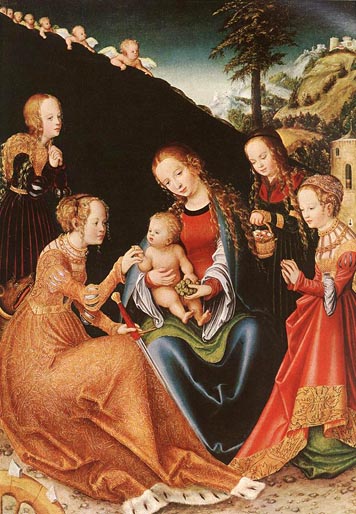
Signed at bottom left with a winged serpent, the artist's sign.
The works of Lucas Cranach the Elder are as varied and full of incident as was his career as an artist. As a young man, he lived and worked in Vienna from 1500 to 1503, the period when he came in contact with the Danube School, whose development was much influenced by his own work. After 1505 he worked as court painter to Frederick the Wise, Elector of Saxony in Wittenberg, and in this citadel of the German Reformation he established and directed a large and busy workshop. In addition to altarpieces and religious pictures he painted mythological subjects, genre scenes and portraits, as well as executed a considerable body of graphic work.
The black wall on the left side of this painting is the result of a later repainting, presumably a curtain was there originally. The decorated garments of the Saints (Margaret, Catherine, Dorothy and Barbara) give an earthly character of the religious subject.
The Annunciation to Joachim: 1516-18
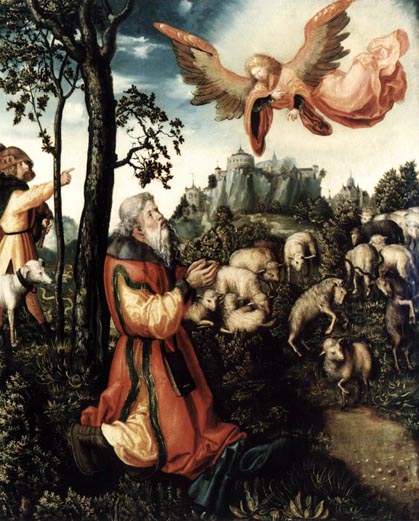
The landscape plays an important role in this scene of joyful spirit in which the angel announces to Joachim that Anne, his wife, will conceive and that the child will be the mother of Jesus.
Virgin and Child under an Apple Tree: 1525-30
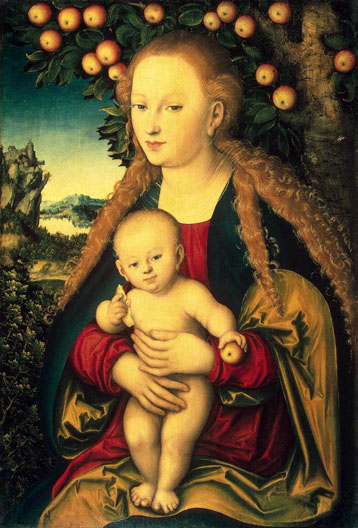
The Child Christ holds bread and an apple in his hands. The apple is the symbol of the original sin, the bread (the body of Christ) of the redemption. The Virgin is considered to be the second Eve redeeming the sin of the first.
Madonna and Child
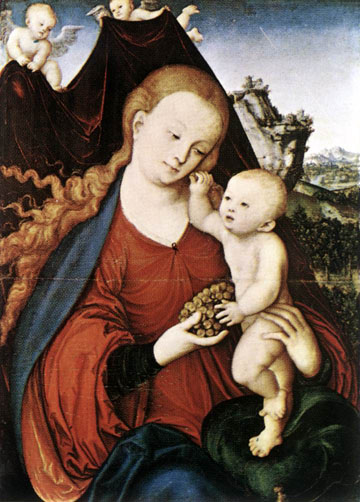
Saint Catherine of Alexandria and Saint Barbara

This diptych came from a Spanish monastery.
Christ and the Adulteress: 1532

Recently some scholars attributed the painting to Hans Cranach, son of Lucas Cranach the Elder. Since the style of father and son was very close to each other it is very difficult to differentiate between them.
The Crucifixion with the Converted Centurion: 1536

Portraits of Henry the Pious, Duke of Saxony and his
Wife Katharina von Mecklenburg: 1514
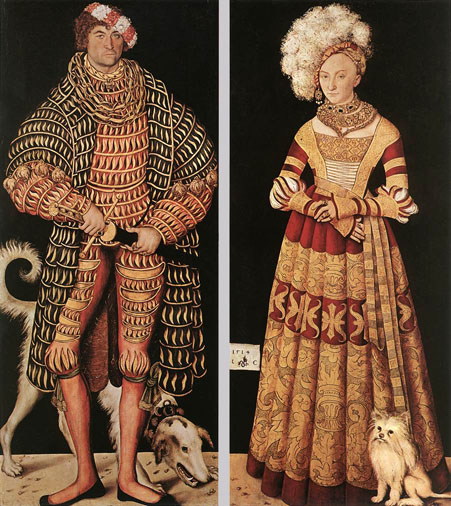
The canvas with the double portrait of the couple was divided into two parts and transferred to wood.
Following his visit to the Netherlands in 1508, Cranach experimented with Italo-Netherlands' ideas of spatial construction and with monumental nudes, but his true talent lay elsewhere, as is shown by the splendid full-length portraits of Duke Henry the Pious and Duchess Katharina von Mecklenburg, which mark the establishment of his official portrait style. Here, space and volume are annihilated; magnificent clothes, set off by a featureless backdrop, are topped by faces reduced to their essential, typical features.
The Saxon princess wears a colorful attire and head-dress characteristic for German noble women in the beginning of the 16th century.
Portrait of a Man: 1514
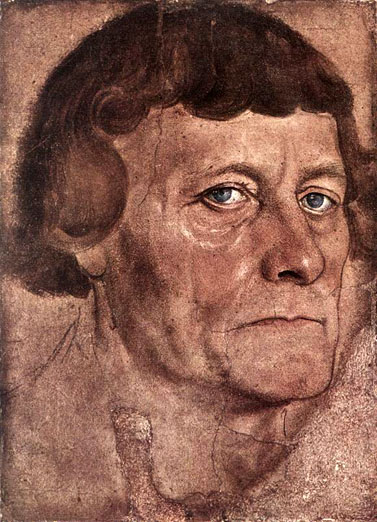
A Prince of Saxony: 1517

There is a companion piece showing a princess. The two children, dressed in characteristic Saxon costumes of the finest type, have been thought to be brother and sister, perhaps the children of Duke George the Bearded. The crown worn by the boy, however, signifies his engagement to be married, and the girl is likely to be his future bride. Cranach, court painter at Wittenberg and the leading artist in Saxony, was in great demand as a portraitist; these two paintings well explain the master's popularity.
A Princess of Saxony: 1517
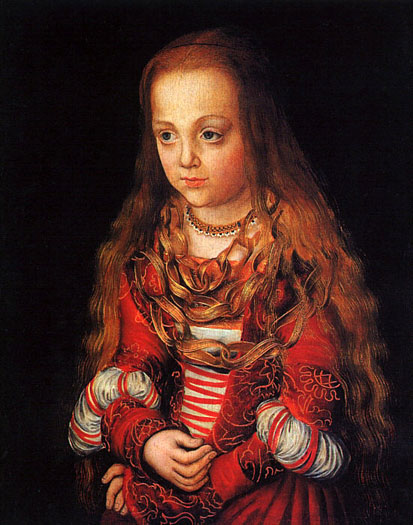
The two children, dressed in characteristic Saxon costumes of the finest type, have been thought to be brother and sister, perhaps the children of Duke George the Bearded. The crown worn by the boy, however, signifies his engagement to be married, and the girl is likely to be his future bride.
Portrait of a Saxon Prince

Portrait of Frau Reuss: 1503
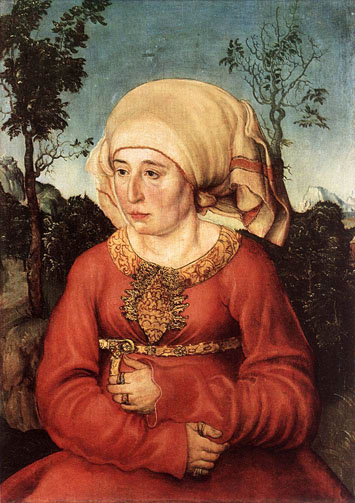
The sitter of this portrait is the wife of a Vienna University law professor. The pendant of this painting, representing the professor, is in the Germanisches Nationalmuseum in Nuremberg. Husband and wife are each flanked a sprouting and a dying tree. Significantly, the two healthy trees face each other, seen on the inner sides of the pendants when hung together. Their emblematic message suggests that only in each other's presence may this couple flourish.
Portrait of a Woman: 1526
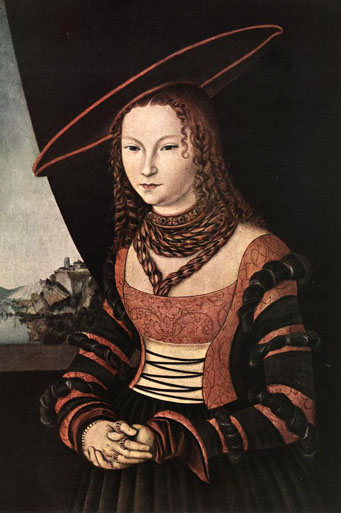
The woman on the painting shows similarity to both Catherina von Bora, Luther's wife, and Sybilla, Princess of Saxony for whom Cranach had great respect. The same figure and face was used in the 1520's on several representations of Judith and Salome by Cranach.
Hans Melber: 1526
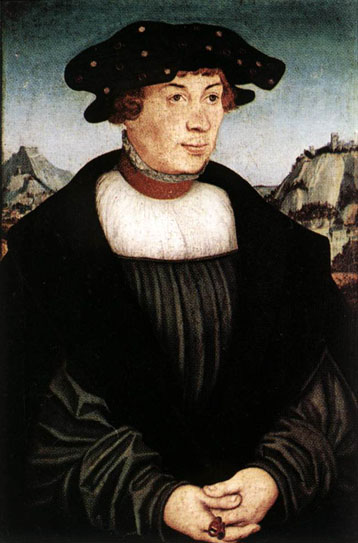
Portraits of Martin Luther and Catherine Bora: 1529

Lucas Cranach appeared in Wittenberg in 1505 as the court artist of Frederick the Wise. Wittenberg, a university town which became the greatest and most authoritative center for the preparation of the Reformation, favored Cranach's contacts and relations with men of culture, like Martin Luther and Philipp Melanchton.
Because the artist too adhered to the Reformation it was only natural that he executed many portraits of Luther. In all Cranach's versions of the famous reformer, the image conveyed is physically faithful, and makes no attempt to conceal the harsh coarseness of Luther's peasant-like head and a certain petit-bourgeois expression.
The two portraits of Luther and his wife are recorded still attached together in 1724. Cranach produced many versions both of the double portrait of the couple as well as the figure of Luther alone, popularizing a type of painting which became established towards the middle of the 1520's and was destined to survive to our own day.
Portrait of a Young Woman: ca 1530

This painting was executed by the workshop of Lucas Cranach. Cranach's productive workshop follows the master's example in presenting us with this bizarre and highly characterized portrait of a lady, achieved with a sinuous and undulating line. The punctilious attention to detail expressed in the tiny decorations of the dress, the tight curly hair and the effervescent hat tells us that this is a fine example of German artistic workmanship.
Portrait of Elector Frederick the Wise in his Old Age: 1525
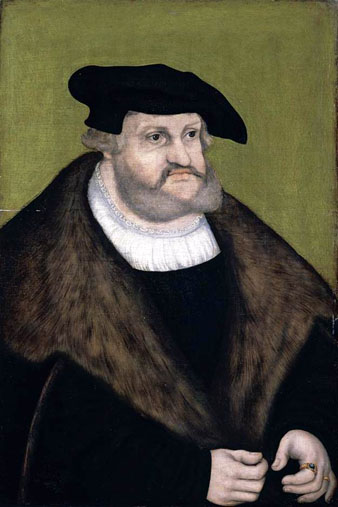
Cranach painted several portraits of the Elector and there are numerous small-scale workshop versions.
Portrait of a Young Woman: 1525-35

The unidentified sitter is represented three-quarter length, as a court beauty, wearing a red cap and a green dress trimmed with gold, her décolletage bedecked with gold chains.
Elector John the Constant of Saxony: 1526
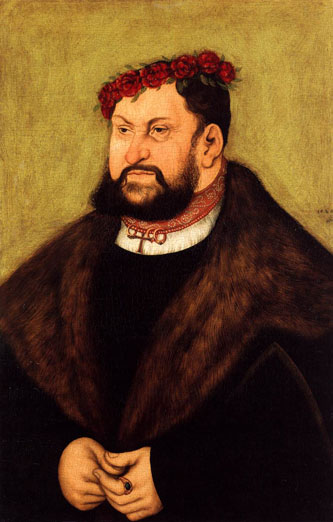
John the Constant (1468-1532) was a member of the Ernestine line of the House of Wettin. During the lifetime of his brother, Elector Frederick the Wise, he became involved in the business of government. After his brother's death in 1525, John the Constant inherited the position of Elector and became Cranach's new master, in which role he proved no less benevolent than Frederick the Wise.
One of Cranach's main duties as court painter consisted in portraying the Saxon princes as well as their families and allies. The portraits were not only intended as documentation of the line of descent for royal ancestral galleries, but also as gifts. The mutual exchange of portraits was a court custom, with the result that we know what John the Constant looked like from a number of paintings by Cranach.
The present half-length portrait shows John the Constant in semi-profile at the age of 58. His arms are elided on the left and right edges of the painting, but the work's narrow format lends the portrait an expression of monumental immediacy. Moreover, the sitter stands out by virtue of the signet ring on his left hand, the chain around his neck bearing several rings and a small cross, and above all the rich embroidery on his shirt collar and the precious fur trim on his gown. The garland of carnations in his hair, traditionally worn at weddings, indicates that the portrait might have been painted on the occasion of the betrothal of the sitter's son, John Frederick the Generous, to Sibylle of Cloves in 1526, and that the Elector is depicted here as the father of the groom.
Johannes Carion: ca 1530

Johannes Carion (Joanis Carionis, 1499-1537) was a historian and court astrologer for Elector Joachim I. He wrote, with the support of Melanchtons, a well respected word chronicle, Chronica (Wittenberg, 1532).
Portrait of Dr Johannes Cuspinian: 1502
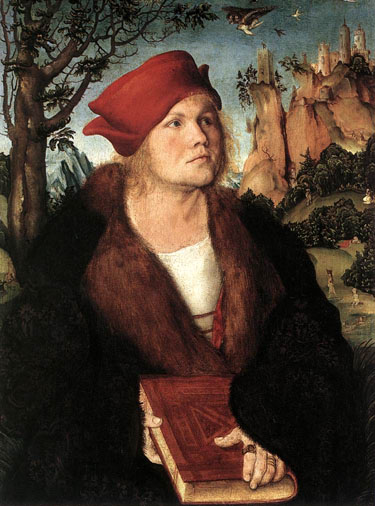
Johannes Spiessheimer (Cuspinian) was a scholar in the court of the Emperor Maximilian I, himself a writer, who made Vienna, through its chancellery and university, the leading humanist city in Germany.
Portrait of Anna Cuspinian: 1502
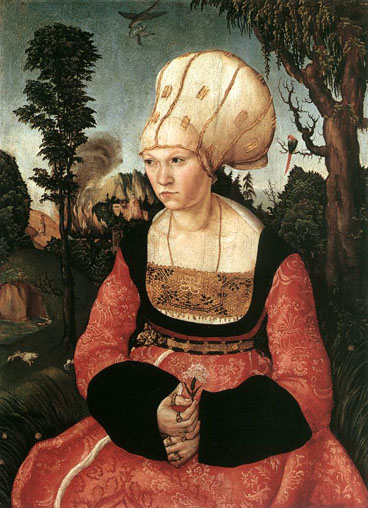
Cranach composed the portraits Dr. Cuspinian and his wife as a pair. This is apparent in the continuity of the landscape behind the elegantly dressed couple. The trees at the edges of the painting, on the left and right of the figures, are placed so that their branches form an arch, imparting an air of grandeur to the sitters.
Portraits (from 1531)
Portraits of Johann I and Frederick III: 1533

The figures occupy only the upper part of the two small portraits, the lower part being taken up by long inscriptions. The paintings portray the two Electors in solemn dress keeping with their status. In these two small works we see the German artist's marked predilection for an almost popular realism, which is achieved by means of a crisp, forceful outline and attention to detail. In Cranach the search for Italian Renaissance beauty is absent; the faces of the sovereigns, both in countenance and expression, are taken to the limit of caricature.
Young Mother and Child
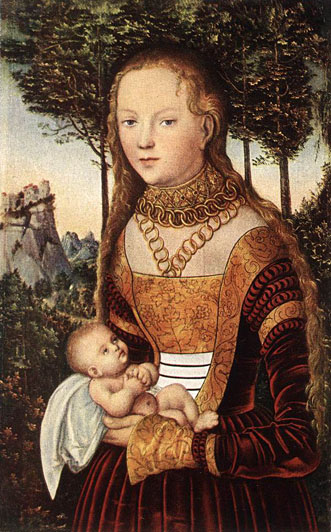
Portrait of a Young Man

Saxon Princesses - Sibylla, Emilia, and Sidonia: 1535
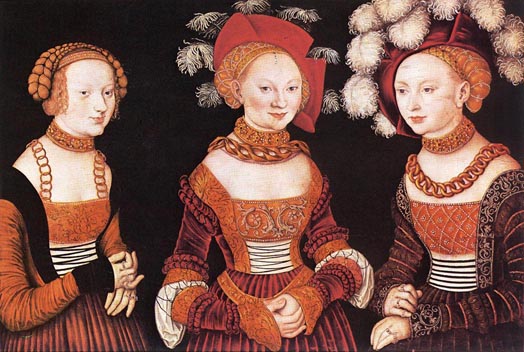
Portrait of a Young Girl: 1540

The Lutheran Museum at Wittenberg has a late copy of this picture, which according to local tradition represents Luther's daughter, Magdalena. However, scholars in the 20th century expressed the opinion that this could not be the case, because the child was born in 1529, and this picture could not be dated later than the 1520's, for stylistic reasons. This opinion is not universally accepted.
Portrait of Dr J Scheyring
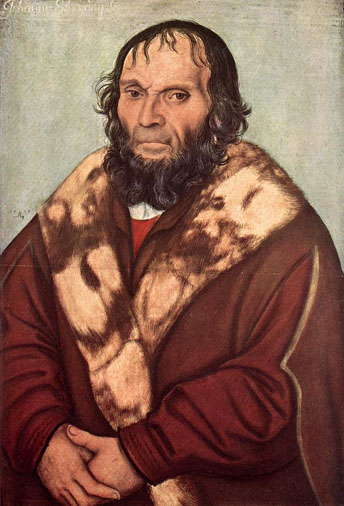
Portrait of Johannes Geiler Von Kaysersberg

Beside his religious and allegoric paintings, Cranach was also a significant portraitist. He painted a lot of portraits during his life, mainly in the period when he worked as a court painter in Wittenberg.
Portrait of Martin Luther: 1543
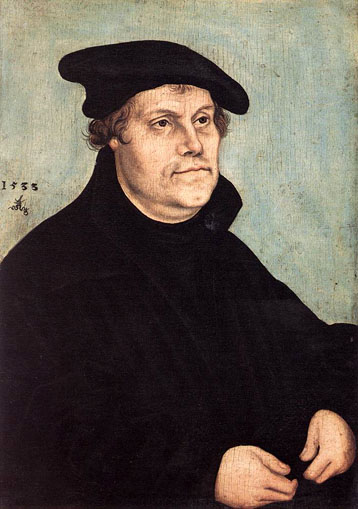
Portraits of Martin Luther and Philipp Melanchthon: 1543
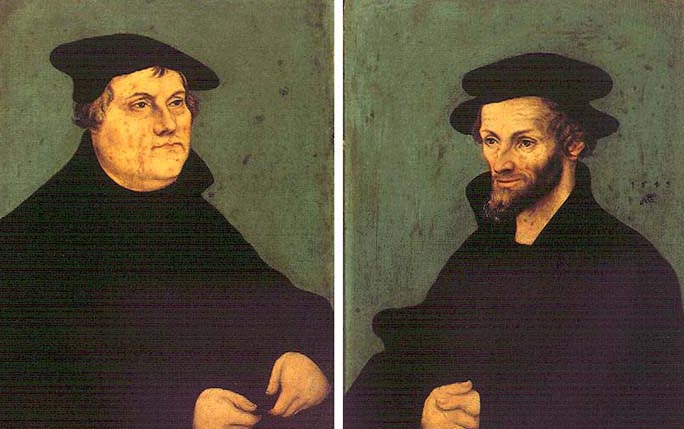
Lukas Cranach the Elder was a political follower and good friend of Martin Luther (1483-1545); the artist often portrayed him, in pendant with other persons as his collaborator Philipp Melanchthon (1497-1560) here, or his wife in the diptych at the Uffizi. The two panels are a workshop replica after the original portraits Cranach had painted towards 1543.
Self Portrait: 1550

The painting is signed and dated.
The Fountain of Youth (1546)
The Fountain of Youth: 1546
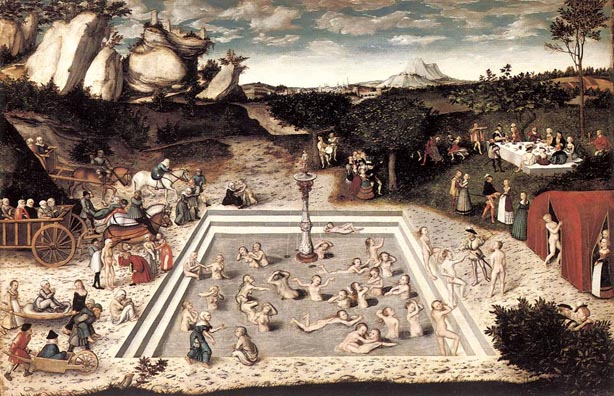
Cranach's painting is about the human yearning for immortality and eternal youth. Human beings dream of being young again, of leaving the worn outer shell and exchanging it for a new one. The notion of the cleansing power of the elements, especially of water, is as old as humankind itself. The center of the scene is a pool filled with water. Some steps lead down to the pool, which is surrounded by a fantastic landscape far from civilization. People have undertaken arduous journeys to reach this solitary spot and bathe in the miraculous waters.
In the left half of the picture wrinkled and frail old women are brought up on carts and stretchers. They are undressed and examined by a doctor before stepping into the water where the gradual process of rejuvenation takes place. Their wrinkles and old sallow skin disappear, their flesh becomes rosy and smooth, and they turn into young girls. As they emerge from the water they are welcomed by a cavalier who shows them to a tent where they receive new clothes. Old peasant women are transformed into young ladies of the court who indulge in the carefree pleasures of life. The jollifications at the festive table, the dancing, music and lovemaking, all take place in a lush flowering landscape. These are the realms of eternal youth, to which the hardships of old age, set in a barren rocky landscape on the left side of the picture, form a stark contrast.
The fountain spouting water from the spring into the pool bears the statues of Venus and Cupid - evidence that this is actually a fountain of love rather than youth, and that the power of love is the true source of immortality.
The Fountain of Youth -(Detail): 1546
_1546.jpg)
Wrinkled and frail old women are brought up on carts and stretchers. They are undressed and examined by a doctor before stepping into the water where the gradual process of rejuvenation takes place.
The Fountain of Youth(Detail): 1546
_2_1546.jpg)
Wrinkled and frail old women are brought up on carts and stretchers.
The Fountain of Youth - (Detail): 1546
_3_1546.jpg)
As the women emerge from the water they are welcomed by a cavalier who shows them to a tent where they receive new clothes.
The Fountain of Youth (Detail): 1546
_4_1546.jpg)
Old peasant women are transformed into young ladies of the court who indulge in the carefree pleasures of life.
The Fountain of Youth - (Detail): 1546
_5_1546.jpg)
The fountain spouting water from the spring into the pool bears the statues of Venus and Cupid - evidence that this is actually a fountain of love rather than youth, and that the power of love is the true source of immortality.
The Fountain of Youth - (Detail): 1546
_6_1546.jpg)
The revelry at the festive table, the dancing, music and lovemaking, all take place in a lush flowering landscape.
_7_1546.jpg)
Return to Pagina Artis
Return to Bruce and Bobbie's Main Page.